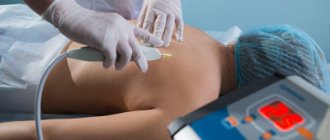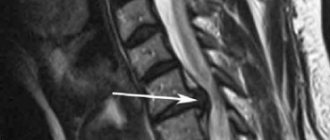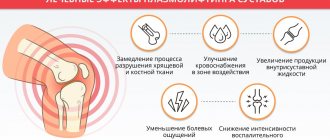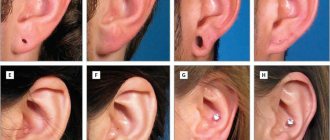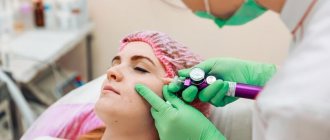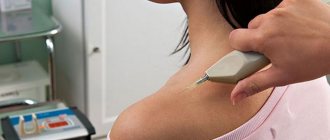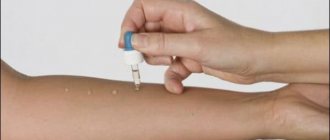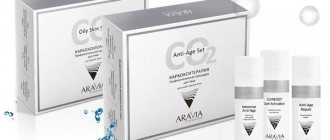The essence of the method
Degenerative-dystrophic changes in cartilage tissue and vertebrae provoke pain. Typically, pathological changes occur due to hypoxia (lack of oxygen), as well as a deficiency of nutrients in tissues due to excessive stress or metabolic disorders. As a result, the muscles become denser, tense, spasms and painful sensations occur. Carboxytherapy for the back and joints is a new treatment method using carbon dioxide. During the procedure, the doctor injects medical carbon dioxide into the joints or muscles of the back near the spine using a special device. After the injection, capillaries expand, blood flow increases, and metabolism accelerates.
Help: Even after the first session of carboxytherapy, the functionality of the body increases, cells and tissues are saturated with nutrients, pain and spasm disappear, and immune defense is activated. Weakened cartilage, blood vessels, and nerve processes are supplied with oxygen, and the symptoms of degenerative disorders become less pronounced. After the procedure, the development of pathology slows down. Carboxytherapy is carried out using special equipment. This device is designed to gently introduce carbon dioxide. Don’t worry, a purified substance is used during the session, which is confirmed by quality certificates. CO2 is not dangerous to the body, it is eliminated in 10-15 minutes.
Mechanism of action
The invasive carboxytherapy method is based on the use of sterile carbon dioxide, which is administered to the patient by injection subcutaneously or intradermally. Since a local state of hypercapnia occurs at the injection site, this causes vasodilation, improved blood circulation, blood flow with oxygen, improved metabolic processes and the removal of metabolic products retained in the cells. The positive effects of invasive carboxytherapy are explained by the fact that carbon dioxide allows it to react almost instantly at the cellular level and interact with fermented components of plasma, protein, and carbohydrate components to form active carbon dioxide and its products, ensuring normalization of pH in tissues. An increase in the level of carbon dioxide in cells and tissues is perceived by them as an external activator of physiological life support processes.
Carbon dioxide is supplied through injections into certain areas of the skin or muscle. After the procedure, the blood condition improves. This is a natural phenomenon, since carbon dioxide is produced in the body, it stimulates all organs and tissues through the blood.
But as we age, all processes slow down and the amount of the substance in the body decreases. Because of this, the space of the blood vessels narrows and its throughput is impaired. After carboxytherapy, blood circulation increases, the affected areas are saturated with useful substances, so their functionality is gradually restored. After the injection, the body is in a state of stress, and hypoxia intensifies. The lumen of the vessels expands, blood circulation is stimulated, after which oxygen begins to be actively released and saturate the tissues. According to studies, the level of beneficial gas after the procedure increases by 3 times or more. To increase the effectiveness of the procedure, injections are made into the most affected areas. CO2 is removed from the body, and oxygen continues to work. Carboxytherapy is used for diseases of the spine and joints - then CO2 is injected into the muscles that surround the affected vertebrae or joints.
What is the essence of carboxytherapy and how does it work?
The older we get, the weaker the subcutaneous capillaries that supply cells with oxygen become. This fact, combined with external stress and other harmful influences, leads to a decrease in the ability of cells to regenerate, so it loses elasticity and the collagen content drops significantly. By the age of 30, oxygen levels decrease by 25%, by 40 – by 50%. Oxygen enters the body through breathing, but due to environmental influences this level is constantly decreasing. As a result, the skin is more susceptible to aging, acne, redness, irritation and age spots.
During the carboxytherapy procedure, carbon dioxide is injected directly under the skin. The body perceives this as a lack of oxygen and responds by increasing circulation and producing new blood cells. As a result, more oxygen and nutrients enter the treated area of the skin, circulation improves and the process of cell restoration begins. The reduction of wrinkles, stretch marks and dark circles under the eyes occurs due to the stimulation of collagen production. The involvement of the deeper layers of the skin leads to long-term and constant production of collagen, and as a result, to a general facelift: the eyelids, cheeks and neck are tightened. To break down fat deposits, such as a double chin, heated gas is injected deep into the skin, breaking down fat cells and stimulating blood circulation and rejuvenation.
To reduce cellulite, nitrogen dioxide is injected deep into the lymphatic system of the thigh, which improves circulation and tissue drainage. The toxins that form the orange peel are destroyed and collagen production is stimulated.
Indications
- Gas injections are used to treat osteochondrosis at any stage, especially during the weakening of the symptoms of a chronic disease.
- In severe forms of pathology, which is accompanied by a bulging intervertebral disc or intervertebral herniation, this technique is also effective.
- Carboxytherapy is used for the following diseases of the musculoskeletal system: Arthritis.
- Arthrosis.
- Rheumatic diseases.
- Inflammatory or dystrophic lesions of periarticular structures.
- Constant pain in the muscles or joints.
Contraindications
Post-infarction or post-stroke condition. Due to the acceleration of blood flow, there is a risk of increasing the area of damage in the heart muscle. Epileptic seizures, mental disorders (possible attack after injection). Angina pectoris (a form of myocardial ischemia, which is accompanied by chest pain). Functional failure of the heart, kidneys or lungs. Liver diseases. Severe form of hypertension. Due to vascular spasm, a hypertensive crisis or stroke may develop. Severe inflammatory processes of tissues or organs. There is a possibility of infection of the area at the injection site and intensification of the pathological process. Period of pregnancy, lactation. There is no evidence that the procedure is safe for the child. Blood clotting disorder. Simultaneous use of diuretics from the group of carbonic anhydrase inhibitors and anticoagulants. Nasal and menstrual bleeding may increase.
The effect of the procedure
Doctors and patients notice positive changes after carboxytherapy sessions: Blood circulation increases in the affected areas. Swelling disappears, the pressure of the vertebrae on the nerve endings decreases. Cerebral circulation disorders and dizziness weaken or disappear. The outflow of lymphatic fluid improves. The functionality of the damaged segments of the spine is restored. The risk of further development of vertebral or joint pathologies is reduced. The activity of the spinal cord is restored. The cartilage layer is saturated with nutrients, and the regeneration of damaged tissue is accelerated. Spasms disappear, as well as pain in muscles and ligaments. The inflammatory process is reduced. Signs of meteopathy (meteosensitivity) are relieved. Headaches caused by diseases of the cervical spine disappear. The functioning of the nervous system improves and sleep improves. Venous blood flow is restored. The breakdown of fats accelerates. Metabolic processes are stimulated, the body is cleansed of waste and toxins. The body begins to produce collagen. The body's defenses are strengthened. As you can see, carboxyterpy is beneficial for the whole body.
Reference. Gas injections demonstrate anti-inflammatory, analgesic, antimicrobial, rejuvenating, and restorative effects. During the procedure, no chemicals are used that can irritate tissues. Carboxytherapy is safe and effective, and results can be seen after the first injection. 1 session lasts no longer than 5 – 10 minutes. After the carboxytherapy procedure, the patient can immediately return to normal activities.
An allergic reaction to gas injections is impossible, this is due to the fact that CO2 is a natural gas that is produced in the body. The risk of infection is also minimal, since sterile instruments and purified gas are used during the procedure.
What should you expect before and after carboxytherapy?
The sensations during the procedure can be compared to slight pulsation or pressure. Minor discomfort usually lasts 2-4 minutes. Carbon dioxide is 20 times more soluble than oxygen, so it spreads easily and quickly from the injection site to nearby tissues. After administration, the gas will be absorbed within 5 minutes, and swelling and slight redness will appear. This process of inflammation will trigger the production of collagen.
The procedure is not accompanied by pain. There may be a slight feeling of tension under the skin as gas is released. The injection site should not be wet for 4 hours. The only side effect may be a bruise if the needle gets into the vessel. However, this only happens in 2% of patients. There is no recovery period.
Stages of the procedure
First, the doctor conducts a diagnosis to identify all areas that need injections and identify contraindications. The specialist must have a certificate that allows him to conduct carboxytherapy sessions. To ensure a positive result, injections are administered into the main areas of concentration of nerves and muscles around the affected joint or along the length of the spinal column. It is important to treat all areas suffering from hypoxia.
How is carboxytherapy performed?
The patient sits on a chair or lies down on a couch. The areas where carbon dioxide is introduced are treated with an antiseptic solution to avoid infection. Using a special device, mini-injections are made that cause virtually no pain. The depth of administration, appropriate pressure, and dose of CO2 are selected by the doctor individually for each patient. During the procedure, the patient may feel a slight burning sensation and crackling under the skin (this is how the gas is absorbed). After a few minutes, the discomfort disappears. After gas injections, it is not recommended to rest; on the contrary, you need to take a walk or do simple physical exercises to speed up blood circulation. This way the effect of the procedure will be more pronounced.
Patients feel relief after the first session of gas injections, after the first procedure. The duration of the therapeutic course is from 3 to 10 sessions. The decision on the duration of the course is made by the doctor, and he takes into account age, general condition, and severity of the pathology. The effect after 1 course lasts for 12 months. To prevent exacerbation of the disease, the patient must undergo 1 additional session once every 4 weeks.
Important: After carboxytherapy, you need to protect the injection site from water. In addition, taking a bath or visiting the sauna is prohibited. It is also better to avoid tight underwear. According to statistics, negative reactions occur in no more than 10% of patients: Swelling, which disappears after a few minutes. A slight cracking under the skin at the injection site also goes away quickly. Most often, injections do not cause discomfort.
How can carboxytherapy restore youth and stop aging?
There are many skin types, and we all age differently. And no matter how you care for your skin, time will still take its toll. You can achieve excellent results by maintaining skin elasticity with collagen. This in turn will prevent sagging of softer tissues and muscles. According to the new concept, it is necessary to begin facelift procedures as early as possible to avoid, or at least postpone, surgical intervention. It is recommended to conduct a course of 4-6 procedures annually with a break of 2-4 weeks.
Price
Carboxytherapy cannot be done in all clinics in Russia; this procedure is carried out only in large medical centers in large cities. However, despite this, this area of treatment is actively developing. The price of 1 session and the entire course depends on the level of the medical institution, equipment, treatment area, and number of procedures. B - prices for carboxytherapy sessions are quite low, so you, dear patients, have the opportunity to immediately purchase a course of treatment of 3-5 sessions.
Carboxytherapy for joints price by zone
| Name of the procedure, zone (area) of implementation | Cost of the procedure, rubles |
| Knee | 2000 |
| Hip | 2000 |
| Ankle | 2000 |
| Elbow | 2000 |
| Hands, fingers | 1000 |
| * Discounts apply: | |
| — 10% for each other area (except the eye area) | |
| — 10% when paying for the course (10 procedures) |
Reviews
Most patients who have experienced the effects of carboxytherapy are satisfied with the result. They say the injections are virtually painless, but there may be some minor bruising on the treated area, which quickly disappears.
- Elena
I suffered from severe arthritis in my hands, and on the advice of a friend, I decided to try treatment with gas injections. After the first session, my condition improved: pain and spasms disappeared, I can clench my hand into a fist and hold not very heavy objects. Now I take the course every 6 months. The disease has almost disappeared, so I recommend it to anyone who suffers from a similar problem.
- Igor
I was diagnosed with an intervertebral hernia after I fell on my back in the winter. The doctor gave me a referral, so it turned out cheaper than I expected. Before the first session, I could not change clothes on my own due to severe pain, so the doctors helped me. After the 3rd procedure, I was already able to bend over on my own! Small abrasions appeared on my back in the injection area, which disappeared after a couple of days. However, this is a small thing compared to the fact that I again gained freedom of movement!
- Alyona
I was diagnosed with radiculopathy, the vertebrae were pinched by the roots of the spinal nerves and blood vessels. The doctor recommended carboxytherapy to me, but I doubted that it would help me, since the severe headache, heart pain, and cramps in the arms and legs made life very difficult. So I decided and didn’t regret it! After 3 sessions, the unpleasant symptoms disappeared, so my opinion about carbon dioxide treatment has changed dramatically!
